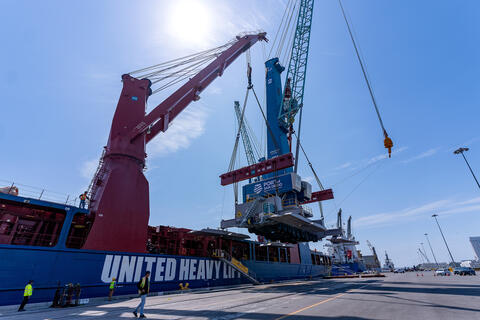They’re Here! Port of San Diego Celebrates Arrival of All-Electric Mobile Harbor Cranes, First in North America
Contact: bpage@portofsandiego.org, 619.348.1518, bpage@portofsandiego.org
Photos and b-roll: https://bit.ly/3Dg7Tup
The Port of San Diego’s two new all-electric Gottwald Generation 6 Mobile Harbor Cranes from Konecranes have been delivered to the Port’s Tenth Avenue Marine Terminal (TAMT). The new cranes are the first of their kind in North America and will help the Port improve public health and air quality, a significant milestone in bringing cleaner air to the Portside Communities of Barrio Logan, Sherman Heights, Logan Heights, and West National City.
“These all-electric mobile harbor cranes are a game changer for public health, the environment, and our regional economy. It’s a win, win, win,” said Chairman Rafael Castellanos, Port of San Diego Board of Port Commissioners. “By replacing our diesel-operated cargo handling equipment with electric equipment, like these cranes, we continue to ensure the air on and around the terminal is cleaner to breathe, we reduce our environmental impacts, and we fulfill our responsibility to support commerce and jobs in our region.”
Media Availability: On Wednesday, July 19, 2023 from 1 to 2:30 p.m., Port Chairman Rafael Castellanos and Port staff will be available at the Tenth Avenue Marine Terminal for one-on-one interviews about the community, environmental, and economic benefits of the all-electric mobile harbor cranes. Members of the media, please notify the Port media team if you are planning to attend and bring a valid form of identification for access on to the terminal. Address: 1290 Water Street, San Diego, CA 92101. Visuals: Two Gottwald Generation 6 Mobile Harbor Cranes from Konecranes, bayfront views.
The cranes are anticipated to be operational later this year. The Port ordered the battery supported electric cranes from Konecranes for approximately $14 million and spent an additional $8.9 million to make the needed electrical infrastructure improvements to support the cranes, which included $2.7 million in grant funding from the San Diego County Air Pollution Control District. They will replace the diesel-powered crane currently in use at TAMT. The conversion from a diesel-powered crane to an all-electric crane system is a big step toward achieving a goal of the Port’s Maritime Clean Air Strategy (MCAS) of transitioning all cargo handling equipment to zero emissions by 2030.
In addition to the public health and environmental benefits, the new crane system will allow the Port to compete for more business. The cranes will represent the heaviest lift capability of any crane system currently in place on the West Coast – up to 400 metric tons (MT) versus the 100 MT lifting capacity of the Port’s diesel crane. Most of the heavy-lift cargoes destined for this region weigh more than 200 MT, including larger pieces of solar, wind, and industrial energy equipment as well as project cargoes. With their heavier capacity and faster offloading speed, the new cranes will also better serve our existing operations when crane movements are needed.
TAMT, one of the Port’s two marine cargo terminals, serves as an omni-cargo terminal consisting of a 96-acre facility and handles breakbulk, bulk, container, and project cargos for solar, wind and hydroelectric power installations, steel, and engines used in local shipbuilding as well as private yachts, refrigerated cargo, soda ash, sugar, paper reams, and more.
In addition to being the first in North America to have all-electric dual mobile harbor cranes, the Port of San Diego:
- Arguably has the most ambitious strategy to reduce pollution from seaport operations through the Maritime Clean Air Strategy.
- Will be the first port in the country to have an electric tug. Crowley is building the eTug and anticipates it arriving in San Diego in the coming months.
- Was among the first ports to have shore power at its terminals, which allows vessels to plug into electric power when they’re in port so they don’t have to run their diesel engines.
- Was among the first ports to adopt a Climate Action Plan in 2013.
About THE Port of San Diego
The Port of San Diego serves the people of California as a specially created district, balancing multiple uses on 34 miles along San Diego Bay spanning five cities. Collecting no tax dollars, the Port manages a diverse portfolio to generate revenues that support vital public services and amenities.
The Port champions Maritime, Waterfront Development, Public Safety, Experiences and Environment, all focused on enriching the relationship people and businesses have with our dynamic waterfront. From cargo and cruise terminals to hotels and restaurants, from marinas to museums, from 23 public parks to countless events, the Port contributes to the region’s prosperity and remarkable way of life on a daily basis.
ABOUT PORT OF SAN DIEGO ENVIRONMENT
Port of San Diego Environment champions the safekeeping and environmental care of our diverse ecosystems. Year after year, environmental goals are set and measured to evolve environmental initiatives – ensuring San Diego Bay remains a vibrant resource and contributes to a remarkable way of life for visitors and residents for generations to come.
